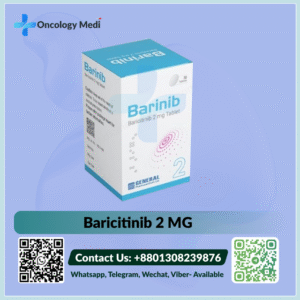Description
Rutinib Cream (Ruxolitinib 1.5) is a topical drug used to treat certain seditious skin conditions similar as atopic dermatitis (eczema) and vitiligo. It’s a cream that has Ruxolitinib, a Janus kinase (JAK) asset with the capability to reduce inflammation, itching, and color changes associated with these habitual conditions of the skin. The cream is a localized and targeted medicine remedy that minimizes symptoms but minimizes systemic exposure.
What Is Ruxolitinib and How Does It Work?
Ruxolitinib, the active component in Rutinib Cream, is a type of medicine known as Janus kinase impediments (JAK impediments). JAK family enzymes, particularly JAK1 and JAK2, play a pivotal part in the signaling that leads to inflammation and vulnerable responses.
When used locally, Ruxolitinib suppresses the inordinate JAK- STAT signaling pathway, which is generally involved in inflammation and vulnerable abnormality in utmost skin conditions. Through the repression of these pathways, the medicine has the following benefits
Reduces greenishness and inflammation
Mitigates vexation and itching
Normalizes saturation of the skin
Enhances complexion
An similar a targeted medium brings relief to those who are intolerant to corticosteroids or other original immunosuppressives.
Uses of Rutinib Cream (Ruxolitinib 1.5%)
Rutinib Cream is substantially used for the following conditions
Atopic Dermatitis (Eczema)
It alleviates itching, greenishness, and swelling of moderate to mild eczema in grown-ups and adolescents 12 times and aged. The cream is used on sensitive skin areas similar as the face, neck, and eyelids where steroid creams can beget side effects.
Vitiligo
Rutinib Cream assists in the restoration of skin saturation fornon-segmental vitiligo by driving repigmentation. Rutinib is particularly useful for small or focal patches of depigmented skin.
In addition to these marketable uses, there are studies under way examining possible benefits in other seditious dermatologic diseases similar as psoriasis and alopecia areata.
How to Use Rutinib Cream
Use only on the affected skin areas as specified by a doctor. Usual conventions are:
Lozenge Use a thin subcaste of Rutinib Cream (1.5) doubly daily on affected areas.
Operate by washing both hands ahead and after operation of the cream. Gently rub into the skin until absorbed.
Duration reprise as directed. Treatment duration may be acclimated depending on condition and response to remedy.
Avoid: Don’t use in open injuries, mucous membranes, or infected skin unless instructed by your doctor.
Don’t use Rutinib Cream under occlusive dressings except as instructed by a medical guru.
Possible Side Effects
In most cases tolerate Rutinib Cream well, but some individualities may witness mild side effects, especially with original treatment administration. The ensuing side effects are frequently observed
Mild burning and surcharging on the area of operation
Greenishness or vexation
Acne or folliculitis (hair follicle inflammation)
Temporary lightening or darkening of the skin
Systemic immersion is extremely uncommon and lateral effects common to JAK impediments, i.e., an increased threat of infections, might follow. This is still not a common miracle with topical medications.
Discontinue the use of the medication in case of severe vexation, symptoms of infection, or unusual circumstances.
Precautions and Warnings
Before applying Rutinib Cream, the following preventives need to be flashed back
Medical History: Inform your doctor if you have a history of frequent infections, vulnerable conditions, or any form of cancer.
The gestation and Lactation Safety of Ruxolitinib in gestation and lactation isn’t well established. Use only where easily necessary and with close medical surveillance.
Avoid Overuse Using further than specified won’t expedite results but can increase the threat of side effects.
Sun Protection Don’t stereotype treated skin to sun or tanning beds, especially in cases with vitiligo, to help sunburn.
This drug is for external use only and shouldn’t be taken by mouth or applied on eyes, mouth, or genitals.
Storage Instructions
Keep Rutinib Cream down from direct sun and humidity in a dry, cool position at room temperature. Store the tube tightly sealed out of reach of children and creatures. Don’t indurate. Discard any unused cream after the date marked on the package.
Benefits of Rutinib Cream
Non-steroidal treatment reduces dependence on topical steroids, minimizing threat of skin thinning and other side effects.
Localized remedy Targets inflammation at the point with minimum or no systemic exposure.
Efficient symptom relief provides nippy relief from itching, greenishness, and discomfort.
Enhanced skin appearance supports repigmentation and return of smooth texture.
Accessible operation, easy-to-apply cream expression suitable for sensitive skin areas.
All these benefits make Rutinib Cream a precious remedial medicine for cases seeking a better and safer medicine for habitual seditious dermatoses.
Availability and Presentation
Rutinib Cream Ruxolitinib 1.5 is available in colorful sizes of tubes, generally 30 g or 60 g grounded on the package of the manufacturer. It should only be specified, and cases should be under the vigilant eye of an suitable dermatologist or doctor.
Conclusion
Rutinib Cream (Ruxolitinib 1.5) is a new and targeted remedy for seditious and pigmentary skin diseases similar as eczema and vitiligo. Through its unique JAK inhibition approach, Rutinib Cream controls inflammation and restores skin appearance to a healthy- looking without causing numerous adverse side effects. Under the guidance of medical professionals, when applied duly, Rutinib Cream has the implicit to significantly ameliorate skin health and quality of life for those who are suffering from long- term dermatological diseases.





Reviews
There are no reviews yet.